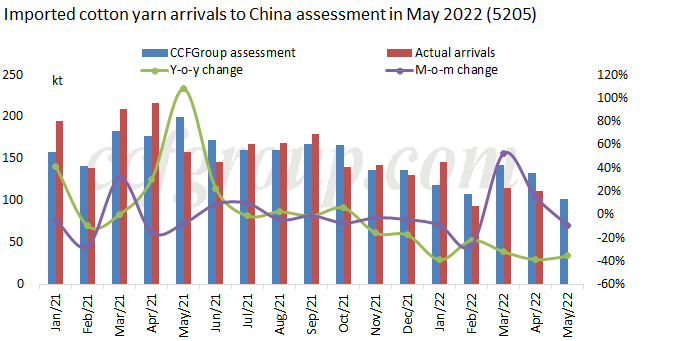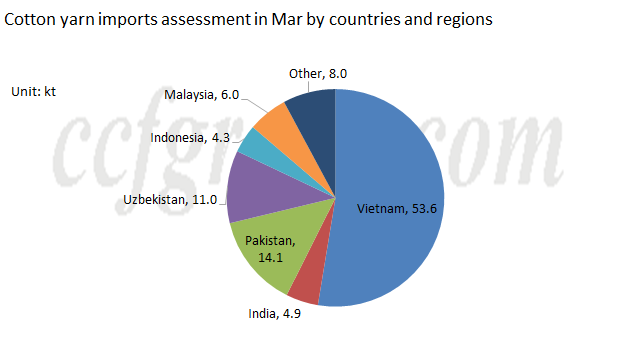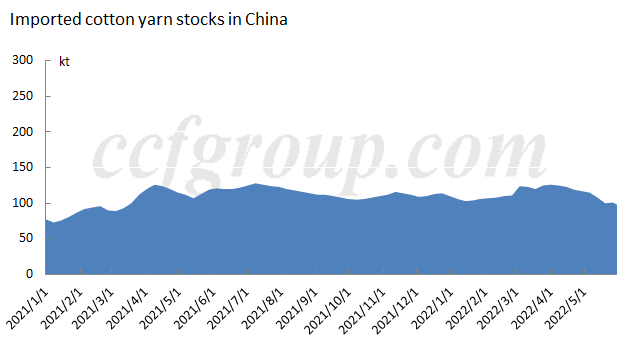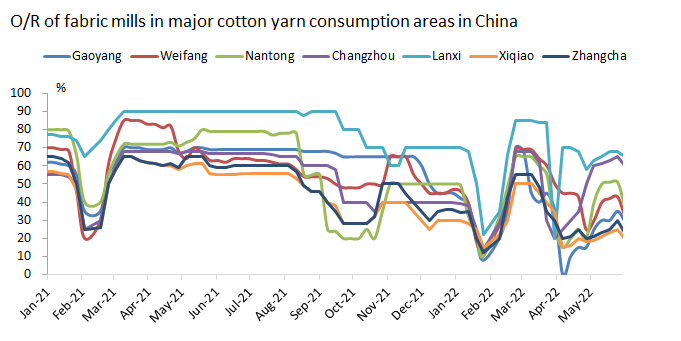May'22 cotton yarn imports may move down 9.02% m-o-m to 101.9kt
1. Imported cotton yarn arrivals to China assessment

According to Apr export data of major cotton yarn import origins and initial research of cotton yarn arrivals of China, May cotton yarn imports of China is estimated at 101.9kt, down 35.51% on the year and down 9.02% on the month. Since last Oct, forward imported cotton yarn has stayed higher than spot one except for the period close to Spring Festival and mid-Mar when their spread narrowed slightly and attracted traders to place orders intensively. In fact, traders reduced stocks this year and the actual arrivals were much less than primary assessment. On the one hand, the production of US cotton and India cotton was strongly expected to reduce last year and foreign cotton kept rising for months. On the other hand, in China local market, downstream demand remained poor and cotton yarn price was hard to move up accordingly. In addition, traditional peak season did not come as expected in Mar, and traders adjusted their strategies. In mid- to late May, the price spread between forward and spot imported cotton yarn narrowed to below 500yuan/mt, and some traders placed orders intensively, but overall procurement volume was far behind that last year. Market participants showed much hesitance facing the risks. Therefore, May imported cotton yarn arrivals to China are expected to inch down than Apr one.
In import origins terms, forward Vietnamese cotton yarn was 1,000-2,000yuan/mt higher than spot one, but the imports of China from it still ranked the first. The import volume was predicted to decline 13.3%. Indian cotton rushed up high under shortage supply and speculation. It stayed at relatively high level despite a small decrease. In mid-to late Mar, offers of forward Indian cotton yarn slightly fell and traders reported that a small amount of low- to medium-count cotton yarn like 16S and 21S arrived in May. So import volume of Indian cotton yarn is predicted a bit higher at 4.9kt. Offers of forward Pakistani cotton yarn did not increase much, and some spinners provided discounts burdened by sales. Apr Pakistan cotton yarn exports increased to 24kt, so that to China is assessed to inch up to 14kt. The Uzbekistani cotton yarn which had been in retention previously arrived in Mar and Apr. Traders mostly reported scarce ordering recently. So May arrivals of Uzbekistani cotton yarn are expected to fall back slightly to about 11kt.

2. Imported yarn stocks keep reducing.

May cotton yarn arrivals kept low and recently, due to the exchange rate fluctuates high, the settlement cost is likely to surge and spot imported cotton yarn price is driven up, but the trade volume reduces obviously and downstream restocking is mainly for rigid demand. Recently as the lockdown in Shanghai was lifted, the export orders for textile and apparels in Jiangsu and Zhejiang increased, accelerating the destocking of imported cotton yarn in some regions. At present, stocks of spot imported cotton yarn are predicted at around 96kt.
3. Downstream operating rate increased slowly.
In May, the control on the pandemic alleviated and the logistic resumed basically, except some markets, like Gaoyang, Hebei were still affected by the pandemic in Beijing. As things stand, downstream operating rate of imported cotton yarn is still largely lower than that in the same period last year. The sales of fabric mills move toughly and the inventory has accumulated to around 40 days. The heavy capital pressure and scarce orders weaken the buying interest of fabric mills.

In conclusion, May arrivals of imported cotton yarn will keep low. Most of recent arrivals were ordered in mid- to late Mar, and the settlement cost has reached high. As most traders did not lock the exchange rate, they may face risks of losses. At present, imported cotton yarn price is much higher than Chinese one, and it will hardly further increase without the support of downstream demand. It is predicted that overall ordering volume will remain low during the slack season.
- Top keywords
- Cotton Price
- Cotton Futures Price
- Cotton Futures
- CZCE
- PTA Futures Price
- Chemical Fiber
- Polyester Prices
- Wool price
- PTA Futures
- Shengze Silk
- China
- Yarn Price
- price
- China Textile City
- Fibre Price
- Benzene Price
- Cotton
- Index
- Cotton Index
- PTA
- fabric price
- NYMEX
- Top 10
- textile industry
- Spot Cotton
- Cotton Yarn
- Polyester Price
- Futures
- PTA Price
- cotton yarn price

